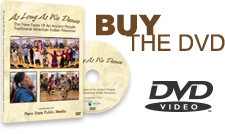Penn State Public Media - As Long As We Dance: The New Faces of an Ancient People Traditional American Indian Powwow
 mediasales.psu.edu
mediasales.psu.edu
Press Inquiries
Matt Caracappa
mnc5000@psu.edu
Program Information
Cheraine Stanford Producer/Director
cps13@psu.edu
814-867-1390

What is a Powwow?
Powwows are American Indian celebrations of community and culture, featuring American Indian drum and dance, as well as American Indian vendors offering Native-made art and craft items.
The exact origin of the contemporary powwow is difficult to pinpoint, but has its roots in traditional gatherings and tribal dances for particular situations. As American Indians were moved onto reservations, their dancing was curtailed by government regulations and so became a powerful symbol of Indian identity. Since the turn of the twentieth century, the intertribal powwow has rapidly developed into a form of expression recognizable to American Indians throughout the continent. The dance and dress styles characteristic of the contemporary powwow owe much to the Northern and Southern Plains peoples, but have spread and adapted to the changes within Indian cultures, powerfully symbolizing both tribally specific and American Indian identity.
The contemporary powwow is a social event, like a big family reunion where everyone comes to renew acquaintances and to dance. It is a time for people to come together in song and dance, a time to put aside tribal differences and help bridge the gap between the American Indian and the non-Indian worlds. However, powwows are not simply secular opportunities for fun; they are a prayer to the Creator, a celebration of spirituality, and a connection with Indianness of past, present, and future. There are two types of powwows: the traditional or honoring powwow, and the nontraditional or contest powwow.